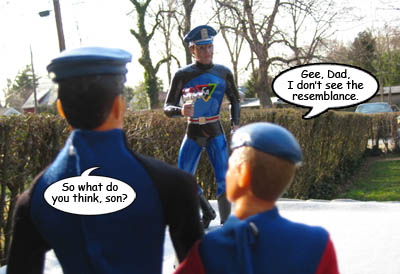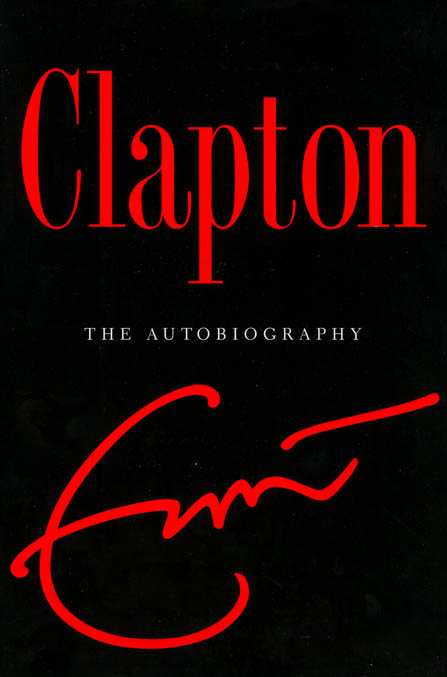If you were a kid in the 70s, Whitman Publishing Company was probably your publisher of choice whether you knew it or not. Whitman produced the Big Little Books, along with various hard and soft cover books aimed at a pre-teen audience. Most of the books were based on movies, TV shows, and comic book titles which were sure-fire favorites with kids. They even repackaged unsold comics into economical three-packs, sealed in flimsy plastic bags that hung from spinner racks in discount stores and book stores. Chances are, if you did any reading as a kid back then, you read Whitman books. 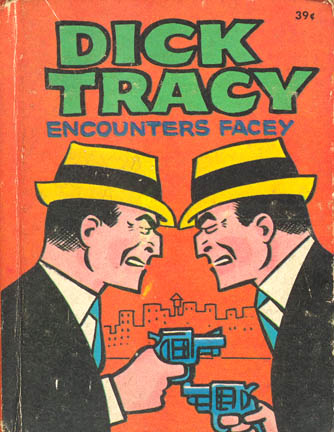 During the summer of ’72 when I crossed the threshold into age eight, I was becoming an avid reader. I was at that awkward reading stage, however, where basic books like “Where the Wild Things Are” and “Cat in the Hat” didn’t really cut it anymore, but I wasn’t quite ready for the Hardy Boys. This is where Whitman bridged the gap. I was already hooked on comic strips and I particularly loved Dick Tracy. During one of my numerous trips with Dad to the Read’s Drug Store (now known as Rite Aid), I found a Big Little Book on the magazine rack titled, Dick Tracy Encounters Facey. This was the first Big Little Book I had ever seen, and I was curious about it. Not only was it quite small (perfect for my pudgy little hands), it had an illustration on each right-hand page and text on each left-hand page. It reminded me of the picture heavy children’s books I was familiar with, but it also had a grown-up feel with its blocks of text and chapter breaks. Just flipping through the book, I saw enough pictures of interesting action and familiar faces like Dick Tracy and Sam Catchem that I had to have it. Another round of begging with my dad, which wasn’t so bad since he was usually pretty amenable to buying me reading material.
During the summer of ’72 when I crossed the threshold into age eight, I was becoming an avid reader. I was at that awkward reading stage, however, where basic books like “Where the Wild Things Are” and “Cat in the Hat” didn’t really cut it anymore, but I wasn’t quite ready for the Hardy Boys. This is where Whitman bridged the gap. I was already hooked on comic strips and I particularly loved Dick Tracy. During one of my numerous trips with Dad to the Read’s Drug Store (now known as Rite Aid), I found a Big Little Book on the magazine rack titled, Dick Tracy Encounters Facey. This was the first Big Little Book I had ever seen, and I was curious about it. Not only was it quite small (perfect for my pudgy little hands), it had an illustration on each right-hand page and text on each left-hand page. It reminded me of the picture heavy children’s books I was familiar with, but it also had a grown-up feel with its blocks of text and chapter breaks. Just flipping through the book, I saw enough pictures of interesting action and familiar faces like Dick Tracy and Sam Catchem that I had to have it. Another round of begging with my dad, which wasn’t so bad since he was usually pretty amenable to buying me reading material.
My dad had to stop off at a couple more places before we went home, so I stayed in the car and read my curious little book while he did whatever. Funny how you could leave an eight-year-old alone in a car back then and not fear any trouble. Different world.
Anyway, I finished reading the book in a few days (always was a slow reader even then). The story involved a criminal known as Facey who was a master of disguise. He started out doing petty crimes for larger criminal gangs, then decided to go solo as his confidence grew. Meanwhile, Dick Tracy and his partner Sam Catchem worked the case, did the forensics and so forth, but couldn’t catch a break. Facey became so self-assured that he even had the guts to masquerade as Tracy himself, walk into the police station, and take away evidence that might lead to his capture. Of course, like all criminals, he pushed his luck too far when he kidnapped the daughter of a world leader. Tracy and Catchem finally tracked him down to his lair and busted him. Facey disguised himself to beat the rap, but Tracy blew his cover by putting him in a shower and washing off his make-up. Pretty entertaining stuff.
I was so taken with the book that I had to tell my best friend Nick about it. When I ran into him, he was carrying a book himself and this one had Superman plastered on the cover. Titled Superman Smashes the Secret of the Mad Director, this book was the size of a regular, mass-market paperback, but it used a similar format as my Big Little Book. That is, lots of pictures and large print, but here the text was on the bottom half of the page and the illustrations were on the top of the page. Only difference was this book had black-and-white drawings rather than the full color pictures my Tracy book had. As I told Nick about my book, he told me how cool his book was as well.
“When you’re done with it, maybe we can swap books?” I suggested.
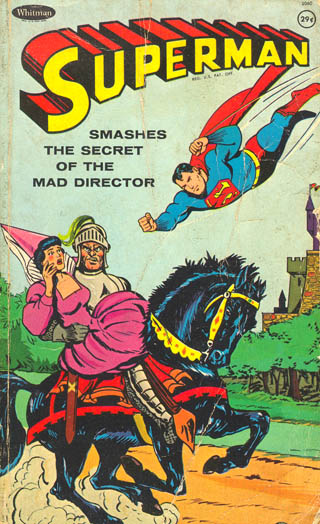
He agreed. I felt so mature. We would exchange books and each get to read two books rather than only one. How civilized. I was growing up. A few days later, on a Friday afternoon, Nick handed me his Superman book and I quickly dashed into the house to retrieve my Dick Tracy book. I was so thrilled. I had never read a Superman story before, not even in comic book form. I made a point of reading the book as fast as I could so that I wouldn’t hang onto the book for too long. That would be rude after all, and we were acting all mature and stuff. The entire weekend, I carried the book around with me and read through a few pages every chance I got. Even while I was playing with my friend Johnny, I would pull the book out of my back pocket and read while he went to the bathroom or ran an errand for his mom. Sunday night, I barreled through the rest of the book and felt quite pleased with myself for finishing a 166-page book so quickly (never mind that half the book was pictures and the print was extra-large).
Looking back, the story was one of the oddest things I’ve ever read. A famous movie director in the Otto Preminger/Eric Von Stroheim mold comes to Metropolis to film a Medieval epic. The tyrannical director, subtly named Max Malice, has a reputation for creating period films of tremendous accuracy, so Clark Kent and Lois Lane are assigned to cover the filming of the movie. They finagle bit parts on the film, Lois as a handmaiden and Clark as a serf, and report for costume and make-up. They are surprised to find out that all actors must wear contact lenses. Clark notices that Malice is putting special lenses on the cameras as well. Somehow these special lenses cause all the reality elements (e.g., city skyline, crew, light stands, etc.) to disappear and the flimsy sets suddenly appear solid and totally real. Also, all the actors lose their memories and actually believe they are in the Middle Ages, except Clark of course, whose Kryptonian physiology must be resistant to the magical contact lenses. Malice dresses as a court jester and encourages the actors to act out the scenes he wants. He talks a couple of thuggish types into fighting Clark and later, the brutes kidnap Lois. Incensed by this attack on his woman, Clark can no longer stay in character, so he transforms into Superman to stop the thugs from running off with Lois. Meanwhile, Max Malice decides that capturing Superman’s escapades on film are more interesting than his original script, so he races madly all over the set in a motorcycle, filming the action from the sidecar while a helicopter captures the action from the air.
As Superman fights with the thugs and generally destroys the set, Malice screams that he is capturing the best footage of his career. What kind of film he could cobble together from these random shots of destruction, I have no idea. Anyway, Superman finally puts an end to the whole mess by burning the film with his heat vision. The rest of the story deals with Clark trying to convince Lois that he’s not Superman even though he disappeared during the whole time that Superman was around. Stupid woman falls for it again.
Although my eight-year-old brain accepted the story at face value, my 43-year-old brain gets a headache from it. How these lenses could make plywood sets look like solid rock and make people believe they were in the Middle Ages is thoroughly mindboggling. Also, Max Malice’s playful ruse to get some good action for his movie seems slim justification for Superman to trash the set and burn Malice’s film stock. Malice slinks away like a chastened criminal without questioning the fact that Superman has cost the studio millions of dollars in damages and lost time. As usual, Superman uses excessive force under the slightest provocation and gets away with it. Little wonder I was Batman fan.
Okay... so I finished the book and excitedly went to Nick after school that Monday to tell him so, hoping that he had also finished my book and we could swap back. Nope, Nick hadn’t had a chance to read it yet. I feigned understanding; we were being civilized after all. I told him he could hang onto it as long as he needed, but I was clever enough to keep his book hostage in the meantime. Days turned into weeks. Nick kept making excuses. After awhile, I gave up asking. I still had his book and sooner or later, he would want it back. I just had to be patient.
Flash forward 35 years: I still had that Superman book collecting dust on the book shelf. I didn’t like it and didn’t particularly want it, but I wanted my Dick Tracy book back, so in some insane twist of logic, I held onto it. That book sat on four different book shelves in four different houses. I haven’t seen Nick in at least 25 years, but I kept hoping my Dick Tracy book would show up. He would finally cave into the guilt and send it to me in an unmarked, plain brown wrapper. I, in turn, would track him down and rightfully return his Superman book. It would be the mature thing to do.
Christmas 2007: Among the gifts that my lovely wife had given me, there was a small, hard package. I curiously peeled away the wrapping. It was a slightly worn copy of Dick Tracy Encounters Facey. I gingerly, but joyously, flipped through the pages, instantly recognizing the illustrations and the story. There’s Facey getting his makeup washed off in the shower! Tears brimmed around my eyelids. I was reunited with a long lost friend. My thoughtful wife had brought my torment to an end.
Nick, you still aren’t getting your book back.
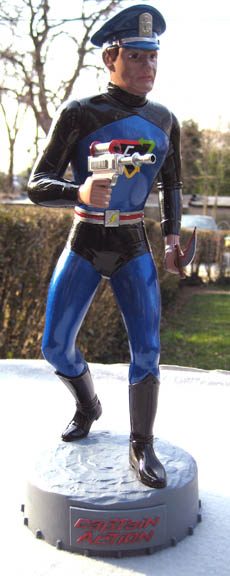 Moebius Models, in conjunction with Captain Action Enterprises, has finally released their long-awaited Captain Action model, a reproduction of the original Aurora model issued in the late 60s. The model kit mimics the original in every detail possible, from the box art to the instruction sheet provided inside, but Moebius also provides some added options for those Captain Action fans who were never quite happy with the original.
Moebius Models, in conjunction with Captain Action Enterprises, has finally released their long-awaited Captain Action model, a reproduction of the original Aurora model issued in the late 60s. The model kit mimics the original in every detail possible, from the box art to the instruction sheet provided inside, but Moebius also provides some added options for those Captain Action fans who were never quite happy with the original.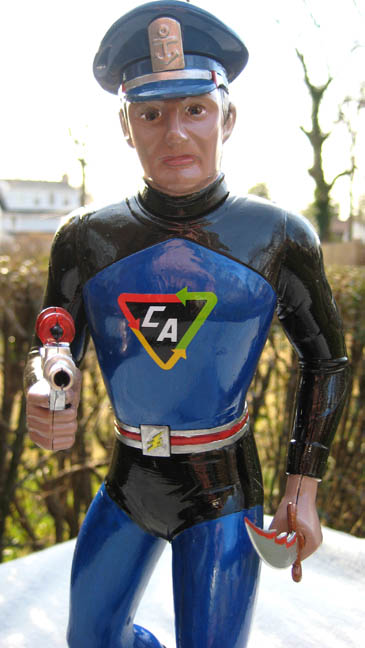 alternative version, or both. Due to production delays, I waited almost a full year before finally receiving my two kits, but I think it was well worth the wait. After opening one of the kits and examining the pieces, I chose to build the alternative version. While I'm not entirely convinced that the new face looks exactly like the box art (and it's certainly nothing like the action figure), it's still a much more interesting face than the dead-behind-the-eyes original.
alternative version, or both. Due to production delays, I waited almost a full year before finally receiving my two kits, but I think it was well worth the wait. After opening one of the kits and examining the pieces, I chose to build the alternative version. While I'm not entirely convinced that the new face looks exactly like the box art (and it's certainly nothing like the action figure), it's still a much more interesting face than the dead-behind-the-eyes original.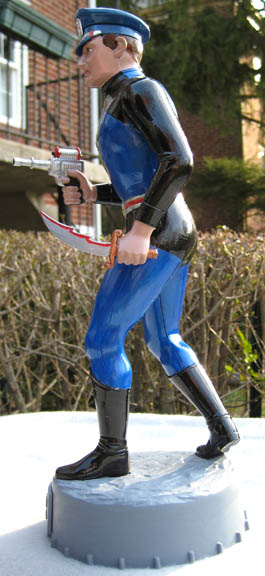 The instructions tell you to assemble the upper body section, then the lower body section, and glue the two assembled sections together. Trouble is, the bottom part of the upper body assembly has pegs which fit into holes along the top of the lower body assembly. If you allow your two assembled body pieces to thoroughly dry before fitting them together, you can't fit the pegs into the holes. I would suggest instead to assemble the lower body section first. Next, glue the face piece to the back part of the upper body, and then glue the front and back pieces of the upper body assembly together while simultaneously fitting the two halves to the assembled lower section. Otherwise, you'll have to pry the two sections apart again to glue them to the lower section. I was lucky and was able to fix the problem without damaging the pieces, but not everyone may be so lucky, so you have been warned!
The instructions tell you to assemble the upper body section, then the lower body section, and glue the two assembled sections together. Trouble is, the bottom part of the upper body assembly has pegs which fit into holes along the top of the lower body assembly. If you allow your two assembled body pieces to thoroughly dry before fitting them together, you can't fit the pegs into the holes. I would suggest instead to assemble the lower body section first. Next, glue the face piece to the back part of the upper body, and then glue the front and back pieces of the upper body assembly together while simultaneously fitting the two halves to the assembled lower section. Otherwise, you'll have to pry the two sections apart again to glue them to the lower section. I was lucky and was able to fix the problem without damaging the pieces, but not everyone may be so lucky, so you have been warned!